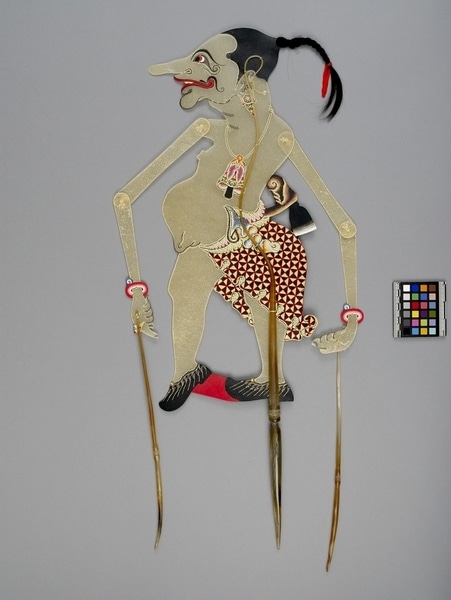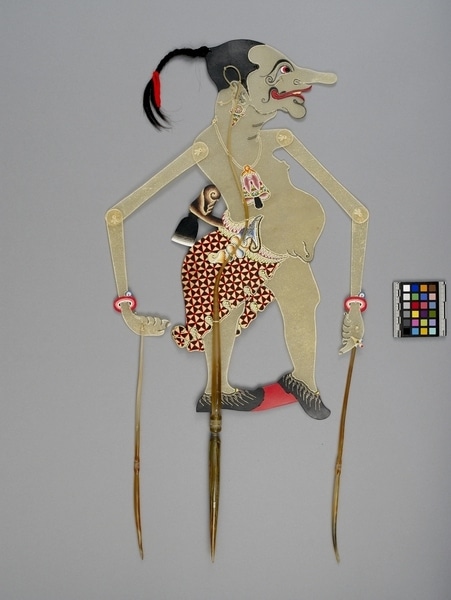Shadow Puppet Item Number: 1568/4 from the MOA: University of British Columbia


Description
Shadow puppet (wayang kulit) representing the character Petruk. Two dimensional, tall, thin man with articulated shoulders and elbows; arms have rods of horn from hands; another long, horn rod has central split and goes up height of puppet on both sides. Man is of a translucent skin with opaque painted decorations of shoes, bracelets, skirt, necklace, earrings, and facial features. Decorations are painted on both sides. Skirt is of a black and gold triangle design with red outlines; waist has a row of red and green alternating triangles above a row of green and gold triangles; fringe is in orange, blue, and white. Shoes are black with gold decoration. Head has braid of dark hair through a hole at the back of the painted hair area; strands of red string tie end of braid.
History Of Use
Wayang kulit shadow play is over a thousand years old. It is thought to be derived from the leather shadow puppetry of southern India, like tholu bommalata, which came to Java with the spread of Hinduism in the first millennium. In Java--part of the largely Islamic Republic of Indonesia--this highly distinctive form of shadow puppetry is valued as a pusaka, a sacred treasure of the royal court of Yogyakarta. The plays are performed to mark special occasions, such as birthdays, marriages, and religious events. They have also been adapted for television and for public education campaigns. At the heart of all performances is the dhalang, the leading artist, puppeteer and gamelan orchestra leader. With immense energy, drama, humour and creativity, the dhalang is responsible for manipulating the puppets; for interpreting their personalities and gestures; for speaking in their particular voices; for narrating the story and for conducting the gamelan orchestra— gongs, xylophones, drums, bowls, vocals, strings. When the play is about to begin, the dhalang places one of his gunungan or kayon—a large leaf-shaped shadow puppet-form representing a tree of life or sacred mountain—in the centre of the screen to separate the opposing groups of puppets and to announce that the cosmic order is in balance. Part way through the play, chaos descends when the four clown characters--Semar and his sons, Bagong, Gareng and Petruk--make an entry. They enliven and delight the audience with their crude and comic behaviours, jokes and songs.
Item History
- Made by Pak Sagio (Maker) in Yogyakarta, Java, Indonesia before 1993
- Owned by Dominique Major before January 25, 1993
- Received from Dominique Major (Seller) and Museum of Anthropology Shop Volunteers (Funding source) on January 25, 1993
What
- Name
- Shadow Puppet
- Identification Number
- 1568/4
- Type of Item
- puppet
- Material
- water buffalo skin, hair, paint, fibre and water buffalo horn
- Overall
- height 78.0 cm, width 26.0 cm, depth 2.0 cm
Who
- Culture
- Javanese
- Creator
- Pak Sagio (Maker)
- Previous Owner
- Dominique Major
- Received from
- Dominique Major (Seller) and Museum of Anthropology Shop Volunteers (Funding source)
Where
- Holding Institution
- MOA: University of British Columbia
- Made in
- Yogyakarta, Java, Indonesia
When
- Creation Date
- before 1993
- Ownership Date
- before January 25, 1993
- Acquisition Date
- on January 25, 1993
Other
- Condition
- excellent
- Accession Number
- 1568/0004